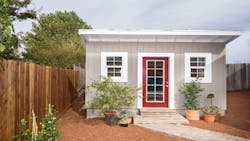4 Custom Home Building Trends Predicted to Grow in 2025, According to the Experts
Looking ahead to 2025, custom home design will reflect homeowner concerns with affordability and environmental factors, according to experts at the 2024 New Home Trends Summit hosted by John Burns Research and Consulting’s New Home Trends Institute.
From smaller homes to wellness-driven designs, these are the home design trends experts say will affect the home building industry next year and beyond.
Smaller, More Functional Homes
As home building becomes increasingly expensive, the custom home building industry is responding with smaller homes. With materials and labor becoming more unaffordable, homeowners prioritize affordability and functionality over sheer square footage.
This shift is causing both builders and designers to reconsider how they utilize space. During the 2024 New Home Trends Summit, Ryan White, director of design at architecture, planning, and interiors firm DAHLIN, stressed the importance of “space count”—the number of versatile, usable areas in a home—rather than the traditional assumptions, for example, that three bedrooms are essential for resale value.
In fact, data from the U.S. Census Bureau’s Quarterly Starts and Completions by Purpose and Design report shows the median single-family square floor area declined to 2,191 square feet, the lowest square footage recorded since 2010.
A Focus on Wellness for Healthier Living
According to Don Ruggles, CEO emeritus at architecture and design firm Ruggles Mabe Studio, environments that ignite the brain’s natural response to beauty through patterns, balance, and harmony can reduce stress and promote emotional well-being.
The custom home industry is also increasingly focusing on wellness design, recognizing the impact of living environments on physical and mental health. Homes now incorporate organic shapes, biophilic components, and other design elements intended to reduce stress and promote well-being.
ADUs and Multigenerational Living
One way to tackle wellness in the home is developing spaces for greater connection, and one solution that has come up in recent years is the creation of more accessory dwelling units (ADUs) or multigenerational suites, which allow aging loved ones to live in or near home.
ADUs have also been used by homeowners as a means to make rental income. While California has seen success with ADU-friendly statewide legislation, other regions will need similar policy changes to promote this housing model, noted experts.
And although ADUs are often pitched as a way to help with affordability, research shows ADUs have had the most success in the luxury custom home market, according to data from John Burns Research and Consulting.
Resilient Home Design for Natural Disasters
Another growing trend in the custom home industry is building for resilience. Builders, architects, and consumers are prioritizing homes that can withstand natural disasters. While willing to pay slightly more for disaster-resistant homes, clients expect these costs to be offset by savings, such as reduced insurance premiums.
This is because as natural disasters have become more common, more residential properties have become at risk of being damaged. According to the 2024 Hurricane Risk Report from property information services provider CoreLogic, more than 32.7 million residential properties in the U.S.—with a total reconstruction cost value of $10.8 trillion—are at risk of hurricane wind damage. Additionally, 7.7 million properties, with a reconstruction cost value of $2.3 trillion, are at risk of storm surge flooding.
